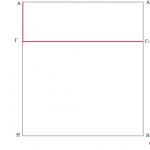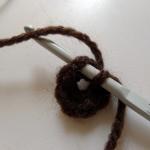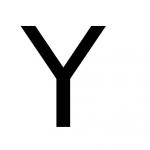Crocheted pincushion cactus. Blooming knitted cactus
Flowers are always beautiful and sweet. They will always decorate your apartment. And when it is not possible to grow fresh flowers, you can simply tie them. Leftover yarn, which knitters keep in large quantities, is perfect for this task.
Tools and materials Time: 4-6 hours Difficulty: 2/10
- Hook: 3.5mm; 3.75mm;4mm; 4.5 mm
- Yarn - various leftovers: dark brown for pot and soil; green for leaves and stems; yellow, red, blue, dark blue, lilac for flowers
- Scissors
- Needle for sewing knitted items
- Filling (sintepon, padding polyester, holofiber, cotton wool)
- Plastic pot
- Wire
- Beads
- We will need hooks of different sizes to knit leaves of all sizes.
This master class will present crocheted flowers in pots with diagrams and descriptions.
Abbreviations:
- VP - air loop
- sc - single crochet
- dc - double crochet
- s2n - double crochet stitch
- с3н - double crochet stitch
- ss - connecting post
- pst - half-column
Step-by-step description with diagram
So, let's start making flowers in a pot, which we will crochet
Step 1: Knitting the soil
Let's start production with the soil, on which our leaves and flowers will later be attached. The soil is a circle that we will knit from dark brown yarn and for work you need to take a 4 mm hook.
Let's start by casting 4 chs and enclosing them in a ring.
Tip: The tail that remains from the set of loops needs to be hidden (so that the product does not unravel in the center). To do this, you need to tie the tail together with the sc ring.
1st row - make 2 ch for lifting and knit another 7 sc. As a result, we should get 8 sc. (photo 1)

Row 2 - increase in each stitch. To do this, knit 2 sc in each loop of the second row. It turns out 8 such increases. As a result, we get 16 sc.

Row 3 – increase in every second stitch. We knit one sc in the first loop, two sc in the second. We repeat this sequence 7 more times. As a result, we get 24 sc.
Row 4 – increase in every third stitch. We knit one sc in the first and second loops, two sc in the third. We repeat this sequence 7 more times. As a result, we get 32 sc.
Row 5 – increase in every fourth stitch. We knit one sc in the first three loops, two sc in the fourth. We repeat this sequence 7 more times. As a result, we get 40 sc.
Row 6 – increase every fifth stitch. We knit one sc in the first four loops, two sc in the fifth. We repeat this sequence 7 more times. As a result, we get 48 sc.
Row 7 – increase in every sixth stitch. We knit one sc in the first five loops, two sc in the sixth. We repeat this sequence 7 more times. As a result, we get 56 sc.
Row 8 – increase every seventh stitch. We knit one sc in the first six loops, two sc in the seventh. We repeat this sequence 7 more times. As a result, we get 64 sc.

Continue adding and knitting in circles until the soil fits into the top of the pot. Then we cut the thread and hide the end of the thread in the loops on the inside of the soil using a hook or needle for sewing knitted items.

Step 2: Knit leaves
We will knit the leaves according to the following pattern:

Leaves need to be knitted in three sizes and 4 pieces of each size. To do this we will need hooks of different sizes - 3.5; 4; 4.5 mm and green yarn.
The small sheet is knitted first. It requires a 3.5 mm hook and the sheet will be about 1.5 cm in length. Take a hook and yarn and make 7 ch. First we knit the right side of the leaf. We knit one dc into the third and fourth loops.

In the next two loops we knit one s2n.

In the last loop of the right side we make three s3n.

Then we turn our work and knit the left side of the sheet. In the first two loops we knit one dc, in the third - 1 dc, and in the last loop we make 1 dc and 1 sc. Next, we knit a ss into the first loop of the first column of the right side.

Make 4 ch to form the stem, secure the thread and leave a tail of 10 cm.

Here is our small sheet and ready. We knit 3 more of the same sheets.
We knit the middle sheet on a 4 mm hook, and it turns out to be about 1.7 cm. The middle sheet is knitted in the same way as the small sheet, except that in the last loop of the right side we knit five dcs. We also knit 4 sheets.

The large sheet is knitted similarly to the medium one. Just take a 4.5 mm hook for work. It is about 1.9 cm long. We also knit 4 sheets.
As a result, we should have 12 leaves of different sizes.
Step 3: Knitting flowers
To make flowers, take a No. 4 hook and yarn (any color of your choice, for example lilac).
We make 4 ch and enclose them in a ring (leaving a tail of 10 cm).
Row 1 – knit 10 sc.

Row 2 – do 3 ch for lifting. Then in the first loop of the second row we need to knit two double crochets. To do this, we make a yarn over, insert the hook into the first loop of the second row and pull out the thread. We have three loops on our hook. Next, grab the thread and knit it through the first two loops. There are two loops on the hook. We knitted the first double crochet stitch. We make another pst in the same loop. We should have three loops on our hook. And now we pull the thread through these three loops and one loop remains on the hook. Make 3 ch and knit a ss into the second loop.

This is how we formed the first petal of the flower.

We repeat this sequence four more times. We fasten the thread and again leave a tail of 10 cm. The result is a flower with five petals.

Now we will make the stamens for the flower. We use a 3 mm hook and yellow yarn.
We cast on 5 ch and make a ss in the third loop from the hook. The first picot was obtained. Then we make a chain of 3 ch and knit a ss into the first loop of the chain. We repeat this sequence two more times. Fasten the thread and cut it off, leaving a long tail. We insert the thread into the needle and pass it through the loop before the first picot, and then in the middle between the second and third picot and tighten.


Stamens can also be made from beads and wire. We string the beads onto the wire and also insert them into the middle of the flower.
We knit 5 more of these flowers.
We knitted all the details of the flower. Now all that remains is to assemble them into a composition. First, we sew large and medium leaves to the soil, and then small leaves.


Here are the flowers we got in the pot.

We presented you with crocheted flowers and leaves with diagrams and descriptions in a plastic pot, but you can knit the pot yourself or tie it around a plastic one.
A description of how to crochet a pot is presented below.
Take a 5 mm hook and yarn of any color. Make 6 chains and enclose them in a ring.
1st row - make 3 ch for lifting, then another 2 ch and knit a dc. Then we do 2 ch again and knit a dc. We repeat this sequence 10 more times. Thus, you should get 12 dc.
You will need: for pots - leftover yarn of different colors, as well as white mohair and black or gray wool mixture (the yarn should not be thin); for cacti - green yarn; for flowers - pink and yellow melange; N 3; molds for pots (for example: plastic containers for dessert).
Description of cacti
Crochet pots: start knitting from the bottom, to do this, knit a chain from the VVP, close it into a ring, knit in a circle, increasing the RLS in 5-6 places, changing the places where the loops are added. Do this until the diameter of the bottom becomes equal to the diameter of the bottom of the mold. Next, knit RLS in height in the round, without adding loops. During the knitting process, frequently apply work to the form; if necessary, gradually add loops so that the workpiece takes on the shape of the form.
- interesting selection for the site!!!
- *** Crochet flower patterns for decorating products
Cactus 1.
Knit from top to bottom, to do this, knit a chain from the VVP, close it into a ring, knit in a circle, increasing the RLS in 3-4 places, changing the places where the loops are added. Knit several rows evenly in the shape of a cylinder and begin to decrease evenly, reducing the number of stitches.
Knitted flower: knit with yellow melange, close 3 ch into a ring, 5 sc, knit in a circle in the shape of a cylinder 5 r., adding 1-2 stitches in each row. Last row of petals: * 10VP, 1СБН*, from * to * repeat as needed.
Cactus 2.
The cactus is knitted from melange obtained by combining green yarn and white mohair. Knit according to the same principle as “Cactus 1”, making decreases and increases in stitches, modeling the shape of a cactus.
Knitted flower: For the base, cast on 3 VPs with green yarn, close into a ring, 5 sc, knit in a circle in the shape of a cylinder with an even fabric 8 r, switch to yellow yarn and knit 1st row: 2 sc in one loop; 2nd row: no additions: 3rd row: evenly add 6 stitches. Last row of petals: *10VP, 1 RLS*, from * to* repeat as needed. Use orange threads to make stamens.
Cactus 3.
Knit from bottom to top. Cast on a chain of 15 VPs, tie 35 double crochets (s/n). Next, knit with relief stitches. There should be 5 ribs in the cactus; to do this, knit *6 concave columns (behind the back wall, 1 convex column (behind the front wall)*. From * to * repeat 5 times. Knit 5-6 rows with an even fabric. Start decreasing: in each r. 1 concave stitch - in each space between the ribs.Tie the remaining 5 stitches to one vertex, pull the thread inward.
Knitted flower: knit with pink melange, close 3 VP into a ring, 8 sc, 3 r. knit with extension. 1r. decrease loops after one.
The soil: knitted from melange obtained by combining gray yarn and white mohair, knitted according to the same principle as the bottom for pots, starting from the base of the cactus.
Assembly: tightly fill the shapes of cacti and pots with padding polyester or other material; you can put a small stone in the pot to make it heavier. Sew details, sew on flowers, do embroidery on pots.
You will need
Yarn 1 (50% cotton, 50% acrylic; 50 g/150 m); yarn 2 (100% polyester; 50 g/95 m);ceramic pots with a diameter of 5 cm and cotton wool as a filler;
hook No. 2.5.
Yarn colors
Earth in flower pots - 1 skein of brown colorCactus round: dark pink (flower), hot pink (flower), pink (flower), pale green (cactus ball)
Branched cactus: green (cactus), pale green, yarn 2 (spines)
Aloe: green (leaves), soft green (leaf edges)
Legend
() = knit in the same stitch** = repeat throughout the entire round
Completing of the work
Earth in a flower pot
Knits the same for all colors.Start with 2 ch.
1st row: knit 6 tbsp. b/n in the 2nd stitch from the hook.
2nd row: 2 tbsp. b/n in each loop = 12 sts.
3rd row: *1 tbsp. b/n, 2 tbsp. b/n in next stitch* = 18 sts.
4th row: *2 tbsp. b/n, 2 tbsp. b/n in the next loop* = 24 p.
5th row: *3 tbsp. b/n, 2 tbsp. b/n in the next loop* = 30 p.
6th row: *4 tbsp. b/n, 2 tbsp. b/n in the next loop* = 36 p.
Rows 7–8: st. b/n.
9th row: *4 tbsp. b/n, 2 tbsp. b/n, tied together* = 30 p.
10th row: st. b/n.
11th row: *3 tbsp. b/n, 2 tbsp. b/n, tied together* = 24 p.
Rows 12–14: st. b/n.
15th row: *2 tbsp. b/n, 2 tbsp. b/n, tied together* = 18 p.
Rows 16–18: st. b/n.
19th row: *1 st. b/n, 2 tbsp. b/n, tied together* = 12 p.
Stuff the resulting part with cotton wool.
20th row: perform 2 tbsp. non-woven, tied together to close the hole.
Break the thread and fasten the ends.
Cactus (round)
Cactus
Knit behind the back wall of the base loops!Start with 2 ch.
1st row: 6 tbsp. b/n in the 2nd v.p. from the hook.
2nd row: 2 tbsp. b/n in each loop = 12 sts.
3rd row: *1 tbsp. b/n, 2 tbsp. b/n in next stitch* = 18 sts.
4th row: *2 tbsp. b/n, 2 tbsp. b/n in the next loop* = 24 p.
5th row: *3 tbsp. b/n, 2 tbsp. b/n in the next loop* = 30 p.
Rows 6–8: st. b/n.
9th row: *3 tbsp. b/n, 2 tbsp. b/n, tied together* = 24 p.
10th row: *2 tbsp. b/n, 2 tbsp. b/n, tied together* = 18 p.
Rows 11–12: st. b/n.
Break the thread and fasten the ends.
Flower
Start with 2 ch. dark pink thread.1st row: 8 tbsp. b/n in the 2nd v.p. from the hook. Switch to a bright pink thread.
2nd row: knit *1 tbsp. b/n, 4 v.p. behind the back wall of the base loops, skip the 1st ch. and knit back 1 tbsp. b/n in the last 3 vp, perform 1 tbsp. b/n in the initial loop*, continue like this
along the entire row. Switch to pink thread.
3rd row: perform *1 tbsp. b/n, 3 v.p. behind the back wall, skip the 1st ch. and knit back 1 tbsp. b/n in the last 2 vp, perform 1 tbsp. b/n in the starting loop*, repeat throughout the row. Break the thread and fasten the ends.
Assembly
Sew the flower to the top of the cactus. Stuff the cactus with cotton wool and sew it to the ground in a flower pot.Cactus (branched)
Knit the initial chain of 15 ch. yarn 1, skip 1st ch. from hook and knit:1st row: 14 st. b/n, ch 1, turn.
Rows 2–19: 14 sts. b/n behind the back wall of the base loops, ch 1, turn.
20th row: connect the loops of the 1st row with the loops of the 19th row. in columns.
Break the thread, leaving an end long enough to sew the entire length of the cactus edges. Fasten the ends of the thread.
Assembly
Embroider spines with yarn 2. Stuff the cactus with cotton wool and sew it to the ground of the pot.Aloe
Big leaf
Knit 10 pieces in total.Work the initial chain of 12 chs, skip the 1st ch. from the hook and knit 1 connection. tbsp., 2 tbsp. b/n, 1 half-column, 2 tbsp. s/n, 3 tbsp. with 2/n, 1 tbsp. s/n, 5 tbsp. s/n into the next loop, continue around the second side of the chain 1 tbsp. s/n, 3 tbsp. with 2/n, 2 tbsp. s/n, 1 half-column, 2 tbsp. b/n, 1 connection Art. Break the thread and fasten the ends.
small leaf
Knit 5 pieces in total.Work the initial chain of 8 chs, skip the 1st ch. from the hook and knit 1 connection. tbsp., 2 tbsp. b/n, 2 half-columns, 1 tbsp. s/n, 5 tbsp. s/n into the next loop, continue around the second side of the chain: 1 tbsp. s/n, 2 half-columns, 2 tbsp. b/n, 1 connection Art. Break the thread and fasten the ends.
Assembly
Using a soft green thread, sew the leaves over the edge using separate stitches. Attach the leaves to the ground of the flower pot: 5 large ones on the bottom, 5 large ones in the middle so that they cover the lower leaves, 5 small ones on top so that they cover the middle leaves.Photo: Burda. Creation 1/2015

Knitted cactus pincushion- we knit an original pincushion in the shape of a cactus. The master class is simple and suitable for beginners.
Materials and tools:
- green knitting threads;
- padding polyester;
- Styrofoam;
- brown paint;
- flower pot;
- hot glue gun;
- knitting needles No. 3;
- hook or needle for stitching.
Description of knitting


Knitting a cactus
We put 11 loops on the knitting needles.
Row 1: knit, yarn over, knit, yarn over and so on until the end of the row. You should get 21 loops;
2nd row: purl all loops and yarn overs;
Row 3: knit, yarn over, knit, yarn over and so on until the end of the row. You should get 41 loops;
Row 4: purl all loops and yarn overs;
Row 5: edge, purl 1, knit 1, purl 1, knit 1. and so on until the end of the row;
Starting from the 6th row, we knit 46 rows with an English elastic band:
Row 6: edge, knit 1, purl 1. remove with double crochet, knit 1. 1 purl. double crochet, and so on until the end of the row;
7th row: edge; one purl remove the loop with double crochet; we knit the loop removed with a double crochet in the previous row together with a knit stitch; knit to the end of the row.
8th row: edge; Using a knit stitch we knit a double crochet stitch; purl remove the loop with double crochet; and so on until the end of the row.
Row 52: knit with 1x1 rib;
Row 53: reduce the number of stitches: 1 edge, 2 knit stitches together, knit 2 stitches together, and so on until the end of the row. You should get 22 loops;
Row 54: purl all;
Row 55: reduce the number of stitches: 1 edge, 2 knit stitches together, knit 2 stitches together, and so on until the end of the row. There should be 12 loops.
Fill with padding polyester and sew.
Many people love flowers. But you don’t always want to take care of them, and sometimes you don’t have enough time for it at all. Therefore, you can buy artificial flowers in the store and decorate your interior with them. Or you can knit the flowers yourself. In this master class we will crochet a beautiful blooming cactus. We will knit a small cactus to decorate the interior, but this craft can also be used as a pincushion. If you want to knit a larger cactus, then you need to initially cast on more loops and make more incremental rows when knitting a cactus pot. Master Class How to crochet a cactus Suitable for both beginner knitters and more experienced knitters.
To crochet a cactus we will need:
- Yarn (green, yellow, pink and sand);
- Hook;
- Needle;
- Sintepon.
How to crochet a cactus master class.
The base of the cactus is a rectangle. We will crochet it in st.b.n.
First, let's cast on eighteen stitches. And now we will proceed to the first row.

We knit the first row. In it we will knit one st.b.n. into each loop.

And now we’ll make an air loop at the end of the row to unwind the knitting and start the second row.
In the second row we will knit the same st.b.n. But they need to be knitted at the back of the loops.
At the end of the second row we will again make one aerial for the turn and the beginning of the third row.
We will perform this and all subsequent rows, like the previous one, using the back walls of the loops.
Knitting behind the back walls promotes the formation of ribbed rows.

The length of the rectangle should be twice its width. You can determine this by eye.

Now we need a needle to sew a cactus. We thread a thread of the same color as the rectangle itself into the eyelet. And we collect loops on top of it.
We pull them together well. And we make a knot.

Then we sew the side of the cactus down to the very bottom. We stuff it with padding polyester. And now we collect the lower loops onto the thread. We pull them together and make a knot.
Original gift:
We will end up with a ball.

And first we take the yellow yarn. We make five air loops. And then we knit a row of st.b.n.

We will cast on five loops and make a dc. into the very first loop so that a loop of air chain is formed.
Let's cast on five more loops and knit another dc at the same point. And so we will knit all five petals.

We place the pink part of the flower on the yellow one. And we sew it on.

You can also make stamens. To do this, simply cut a couple of short strips of pink and yellow yarn and sew them to the middle.
And bookmark this idea for Easter:
All that remains is to tie the pot. And we knit it with sand-colored yarn.
We knit a circle. First we knit six st.b.n. In the second row there are two st.b.n. in the loops. So we will have twelve senior scientific degrees.
One row must be knitted behind the far walls (back) of the loops.
We knit another row, but for the entire loop.
Then we knit an increase in the row through two loops. And we will perform the new row without increments.
Then we will knit increases through four loops. And a row without them.
And we finish knitting one row with increases through five loops and one row without them.

You can put a cardboard circle on the bottom. Then the pot will be more stable.
We fill the pot with padding polyester. And carefully sew the cactus to the pot. It is better to sew it with thin threads and a neutral color so that the seams are invisible.
We hide or cut off the excess threads.

Now you know how to crochet a cactus and easily decorate your home with such cute decorations!






